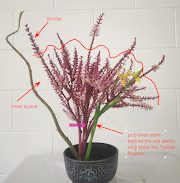Colour 1
Colour 1 - Task
Ikebana Aesthetics Program - Zoom Ikebana DojoLearn about the four Ikebana elements online in September & October 2020. Beginners welcome. 日本からのご参加歓迎いたします。
When:
Session 1, 4:00 - 4:30 PM, 17 October 2020 (Melbourne Time) - Fully Booked
Session 2, 4:00 - 4:30 PM, 24 October 2020 (Melbourne Time)
Facilitators: Shoso Shimbo & Shoan Lo
Who can Join: Anyone, regardless of ikebana school, stage of learning or country of residence. Beginners welcome. You must be familiar with Zoom. Sessions will be conducted in English.
How Much: Aus $10 for one session. Pay by bank transfer (within Australia, type your name in reference) or credit card or Paypal.
Overview
Colour refers to the wavelengths of light. Colour theory is important but there is so much to learn about it. We cover only small basics of it in this course. Please remember that all ikebana masters are the masters of colours!
In this course we aim to create poetry in ikebana. The most important part of colour theory for ikebana practitioners is colour schemes. If there is no colour schemes in your design, there is no harmony and no poetry.
First, be familiar with colour wheel. It is easy to recognise warm & cool colours. Colours of the red-yellow side of the wheel are warm, while the colours on the blue-green sider are cool. Effects of those colours are obvious.

Next, let’s learn the basics of colour schemes. These are not formulas to follow, but are helpful knowledge for picking colours or flowers for your design.
a. Monochromatic colour schemes. They use variations of one colour, for instance light blue and dark blue.
b. Analogous colour schemes. They use several colours that are adjacent on the colour wheel.
c. Complementary colour schemes. Colours opposite each other on the colour wheel are called compliments. Colour schemes that use such colours are called complementary schemes. Red - green, blue - orange, yellow - violet are examples of complementary pairs.
See Session Notes Colour 1 for more about these colour schemes.
FAQ: Do we have to consider the colour of container, foliage or branches in using colour schemes?
Answer: It depends. If those factors play important roles in your design, the answer is YES. Black or white containers are often recommended for beginners, because they don’t have to pay much attention to effect of the colours of containers. It is not wise to expect beginners to pay attention to ALL colours involved. Focus on the colors of flowers first.
In colour 1 be familiar with the basic of colour schemes. We will explore more sophisticated colour schemes in Colour 2 & 3. For more about Colour in Ikebana, refer to a short essay, "Introduction to Ikebana Aesthetics" by Dr Shoso Shimbo (available shortly in English & Japanese).
Objectives in Colour 1
1. Become familiar with using colour schemes.
2. Try an analogous colour scheme in your design. Choose 2 similar colours from the colour wheel.
3. Use moribana style (use kenzan, florist form or others for easy fixture) or Nageire style (see Session Notes Colour 1 for detailed Nageire techniques).
4. Observe the result and feel the effect of the colour scheme.
5. Advances students may consider using more sophisticated colour schemes.
What You Need
5. Advances students may consider using more sophisticated colour schemes.
What You Need

1. secateurs
2. kenzan or florist foam or wire packed container (see a task for Balance 1) for moribana style. You don't need these if you are going to try Nageire Style (sample image).
3. container - any include a cup.
4. flower materials:
- Lineal materials - poa poiformis or grass tree
- Leaves - syngonium podophullum
- Flowers - carnation & statice
Flower materials are guide only. You can choose any other materials as long as you focus on the topic.
How to Make It?
You will receive Session Notes Colour 1 with step-by-step instructions for making your arrangement after your payment is received. Our free video and the Session Notes will help you make your ikebana work.
How to Apply & Participate
Apply by 13 October for Session 1, 4:00 - 4:30 PM, 17 October 2020
Apply by 20 October for Session 2, 4:00 - 4:30 PM, 24 October 2020
Step 2 - Pay
(2) If your application is accepted, you will receive an email with instruction on how to pay. Please visit our orientation page for more practical advice on how to use Ikebana Dojo.
(3) Upon receipt of your payment, we will send you an email of invitation to the session & session notes on how to make our sample work.
Step 3 - Get Ready
(4) Do your assignment. Make your ikebana work before the session.
(5) Take a photo of your work (less than 0.5 Meg.) and send to ikebana.dojo@gmail.com at least 24 hours before the session starts if you want detailed feedback.
(6) Alternatively, you can share the photo of your work during the session. Find a way to share your file using Zoom.
Step 4 - Join Dojo
(7) Join the session. Prepare your work and its photo.03:55 PM Australia/Melbourne: Please join the session, and check your connection etc.
04:00 PM Australia/Melbourne: Let’s start session together.
04:30 PM Australia/Melbourne: Session closes
04:00 PM Australia/Melbourne: Let’s start session together.
04:30 PM Australia/Melbourne: Session closes
Step 5 - Rework
(9) Share a photo of your work to Ikebana Gallery Facebook Page. See how to apply for Ikebana Gallery Award if you are a student.(10) If you would like to join Zoom Ikebana Dojo again, please visit our pages on Ikebana Aesthetics Program or Special Program.
Samples for Advanced Students
Ikebana Aesthetics Curriculum
生花道場カリキュラム(日本語)

























